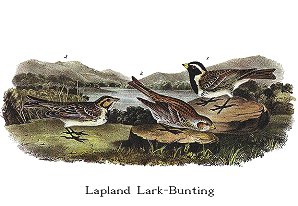
| Family XV. FRINGILLINAE. FINCHES. GENUS I. PLECTROPHANES, Meyer. LARK-BUNTING. |
Next >> |

Family |
LAPLAND LARK-BUNTING. [Lapland Longspur.] |
| Genus | PLECTROPHANES LAPPONICA, Linn. [Calcarius lapponicus.] |
My first acquaintance with this species took place on the 15th of February,
1819. Walking with my wife, on the afternoon of that day, in the neighbourhood
of Henderson, in Kentucky, I saw immense flocks scattered over the open grounds
on the elevated grassy banks of the Ohio. Having my gun with me, as usual, I
procured more than sixty in a few minutes. All the youths of the village turned
out on this occasion, and a relative of mine, in the course of the next day,
killed about six hundred. Although in rather poor condition, we found them
excellent eating. Three days after they disappeared as suddenly as they had
arrived, for although on the previous evening they seemed as numerous as ever,
none but wounded birds were to be seen in the morning. Whilst at Shippingport,
near Louisville, in the same State, I found a good number of these birds on the
commons, feeding in company with Shore Larks and Snow Buntings, and obtained
some dozens. Among all the specimens which I procured in that part of the
country, none were in perfect or summer plumage, most of them being in the garb
of the male, as represented by the second figure of my plate.
In their movements they resemble the Snow Bunting. They run and hop on the
ground with ease and celerity, many making towards a tuft of withered grass at
the same time, to search for the few seeds that may yet be procured around or
beneath it, and all the while littering a repetition of chirps, in a rather low
and plaintive accent. When on wing, to which they resorted after each discharge
of the gun, or when nearly approached, they formed into compact bodies, wheeled
and cut to and fro through the air, now high, now low, in the manner of Larks,
alighting suddenly, and perhaps immediately flying off again to renew their
curious evolutions. At times flocks composed of hundreds would settle on the
top-rails of fences, or on the lower large branches of the trees in the fields;
but on such occasions they appeared as much discontented as the Snow Buntings
are, when they also alight on trees, fences, or houses.
The Lapland Longspur visits the neighbourhood of Louisville in Kentucky
almost every year, but seldom appears when the weather is not intensely cold. I
found it also in the vicinity of St. Genevieve in Missouri; and it seems
surprising that none were observed near the Columbia river by Mr. TOWNSEND.
The best account of this species, as observed in the northern latitudes of
America where it breeds, is that given by Dr. RICHARDSON, in the Fauna
Boreali-Americana. After stating that it is common in the northern regions of
both continents, he says:--"I never met with this species in the interior of the
Fur Countries during winter, and I suspect that its principal retreats in that
season are on the borders of Lakes Huron and Superior, and in the country
extending to the westward on the same parallel. In the year 1827, it appeared
on the plains at Carlton House, about the middle of May, in very large flocks,
among which were many Shore Larks (Alauda alpestris) and a few individuals of
Emberiza picta. During their stay of ten or twelve days, they frequented open
spots, where recent fires had destroyed the grass. They came to Cumberland
House a few days later in the same season, and there kept constantly in the
furrows of a newly ploughed field. In the preceding year they were seen, though
in smaller flocks, in the vicinity of Fort Franklin (lat. 65 1/2 degrees) in the
beginning of May; and the crops of those that were then killed were filled with
the seeds of the Arbutus alpinus. They breed in the moist meadows on the shores
of the Arctic sea. The nest, placed on a small hillock, among moss and stones,
is composed externally of the dry stems of grass, interwoven to a considerable
thickness, and lined very neatly and compactly with deer's hair. The eggs,
usually seven, are pale ochre-yellow, spotted with brown.
The figure of the male in summer plumage represented in my plate, was drawn
from a beautiful specimen in the collection of my esteemed friend Captain JAMES
CLARK ROSS of the British Navy.
LAPLAND LONGSPUR, Emberiza lapponica, Bonap. Amer. Orn., vol. i. p. 53.
EMBERIZA LAPPONICA, Bonap. Syn., p. 440.
EMBERIZA (PLECTROPHANES) LAPPONICA, Lapland Buntling, Swains. & Rich. F. Bor. Amer., vol. ii. p. 248.
LAPLAND LONGSPUR, Nutt. Man., vol. i. p. 463.
LAPLAND LONGSPUR, Aud. Orn. Biog., vol. iv. p. 473.
Male, in summer, with the head and fore part of the neck black; a white
band over the eye, passing along the neck, and margining the black; a
brownish-red crescent on the hind neck; the feathers on the rest of the upper
parts black, broadly margined with yellowish-red; first row of small coverts
tipped with white; lower parts white, the sides streaked with black. Male, in
winter, with the upper part of the head black, the feathers edged with
brownish-red, cheeks and band over the eye greyish-yellow; feathers of the fore
neck black, broadly tipped with white; dark streaks on the sides not apparent.
Female with the upper parts reddish-grey, spotted with black; a greyish-white
band over the eye; the cheeks greyish-brown; lower parts greyish-white, the
sides streaked with dusky.
Male, 6 9/8; wing, 3 10/12.
| Next >> |